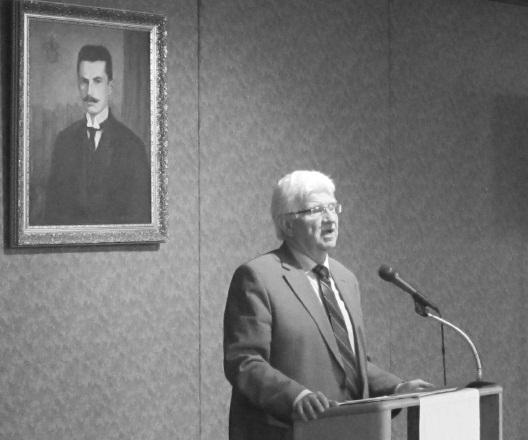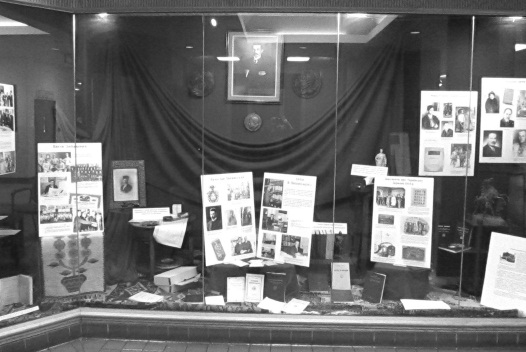CIUS
Professor Marks Anniversary of Lypynsky Institute
 On
March 17, 2013, the fiftieth anniversary of the W. K. Lypynsky East
European Research Institute was marked by a grand celebration at the
institute’s headquarters in Philadelphia, Pennsylvania. This was
also the twenty-fifth anniversary of the death of one of the
institute’s founders, Eugene Zyblikevych. Participants included Dr.
Zenon Kohut, director of the Kowalsky Program for the Study of
Eastern Ukraine at the Canadian Institute of Ukrainian Studies
(CIUS), and Dr. Tetiana Ostashko, a senior researcher at the
Institute of History, National Academy of Sciences of Ukraine (Kyiv).
On
March 17, 2013, the fiftieth anniversary of the W. K. Lypynsky East
European Research Institute was marked by a grand celebration at the
institute’s headquarters in Philadelphia, Pennsylvania. This was
also the twenty-fifth anniversary of the death of one of the
institute’s founders, Eugene Zyblikevych. Participants included Dr.
Zenon Kohut, director of the Kowalsky Program for the Study of
Eastern Ukraine at the Canadian Institute of Ukrainian Studies
(CIUS), and Dr. Tetiana Ostashko, a senior researcher at the
Institute of History, National Academy of Sciences of Ukraine (Kyiv).
Dr.
Kohut gave a presentation in memory of Zyblikevych titled “Habent
sua fata libelli: The Long Road of Two Monographs Devoted to Herman
Petro Doroshenko.” He presented an intriguing history of two
biographies of Herman Doroshenko (1665-76), one written by a distant
relative, the famous Ukrainian historian and political figure Dmytro
Doroshenko (1882-1951), the other by the Polish scholar Jan Perdenia
(1898-1973).
As
Dr. Kohut pointed out, Dmytro Doroshenko was a historian of the
“statist school” in Ukrainian historiography. He saw the elites
of the early modern Ukrainian Cossack Hetmanate as having the
political acumen required to build a state. This was in direct
contrast to Mykhailo Hrushevsky, who insisted on the critical
importance of mass-based national movements in the development of
statehood. For the historian Doroshenko, Hetman Petro Doroshenko was
something of an ideal statesman. He argued that Petro Doroshenko was
totally committed to a united Ukraine, but he also candidly described
the devastating effects of the pro-Turkish policies that the hetman
was forced to adopt after Poland and Muscovy partitioned the
Ukrainian lands in the Truce of Andrusovo (1667).
Dmytro
Doroshenko’s monograph was the result of assiduous research on
printed sources and archival materials from depositories in Warsaw,
Cracow, Poznari, and Lviv. His citations and references are of
exceptional value today, as many documents held in Polish archives
were destroyed during World War II.
Jan
Perdenia’s monograph focuses on the relationship between the
Cossack hetman and the government of the Polish-Lithuanian
Commonwealth. Unable to access Doroshenko’s work, he used numerous
sources from both Polish and Soviet (Moscow and Leningrad) archives
and libraries. Thus the two monographs complement each other.
 Even
though Perdenia worked in Poland under the communist regime, which
censored historical and other literature, his conclusions about
Hetman Petro Doroshenko as a political actor were generally similar
to those of Dmytro Doroshenko. His main argument was that all the
hetman’s political activity concentrated on ensuring the unity and
independence of Cossack Ukraine. A notable difference, however, is
Perdenia’s contention that Doroshenko was a treacherous politician
who bore responsibility for the failure of Polish-Cossack
negotiations. Perdenia also presented an idealized portrait of King
Jan III Sobieski. It is difficult to determine whether these were
Perdenia’s own views or observations imposed by the censors.
Even
though Perdenia worked in Poland under the communist regime, which
censored historical and other literature, his conclusions about
Hetman Petro Doroshenko as a political actor were generally similar
to those of Dmytro Doroshenko. His main argument was that all the
hetman’s political activity concentrated on ensuring the unity and
independence of Cossack Ukraine. A notable difference, however, is
Perdenia’s contention that Doroshenko was a treacherous politician
who bore responsibility for the failure of Polish-Cossack
negotiations. Perdenia also presented an idealized portrait of King
Jan III Sobieski. It is difficult to determine whether these were
Perdenia’s own views or observations imposed by the censors.
The
texts of both monographs barely survived and were not published until
decades after the deaths of their authors. Dmytro Doroshenko’s
monograph reached the West after the Prague Spring of 1968. It was
presumably sent by a Ukrainian scholar and public figure from
Czechoslovakia, Orest Zilynsky, to the president of the Ukrainian
Free Academy of Sciences in the U.S. (UVAN), Professor Oleksander
Ohloblyn, and finally published in 1985 with the support of UVAN. Jan
Perdenia completed his work in 1971, but the Polish authorities did
not consent to the publication of his controversial book. Shortly
before his death, Perdenia passed on his manuscript to Dr. Frank
Sysyn, who smuggled it to safety in the West. The book was finally
published in 2000. Both monographs provided a basis for the most
recent study of the life and work of Hetman Petro Doroshenko, issued
in 2011 by the Ukrainian historians Valerii Smolii and Valerii
Stepankov.
The
W. K. Lypynsky East European Research Institute was founded in 1963
at the initiative of Ukrainian activists in Philadelphia: Vasyl
Kostrubiak, Dmytro Levchuk, Oleksander Lototsky, Volodymyr Chuma, and
Eugene Zyblikevych. The purpose of the institute is to acquire,
preserve, and publish works and materials from the personal archives
of Viacheslav Lypynsky and to conduct research related to Ukrainian
nation-building and intellectual history. The institute’s archive
also houses documents of Metropolitan Andrei Sheptytsky, Hetman Pavlo
Skoropadsky and his family, Prince Mykhailo Kochubei, the historians
Dmytro Doroshenko and Volodymyr Zalozetsky, the writers Vasyl
Stefanyk and Bohdan Lepky, a member of the Directory of the Ukrainian
People’s Republic, Opanas Andriievsky, the Ukrainian military
figures Oleksander Shapoval and Varfolomii Yevtymovych, the Ukrainian
scholars Levchuk and Lototsky, the artists Vasyl Avramenko and Viktor
Tsymbal, and others. There are also materials from the Committee for
Famine Relief in Ukraine (1932-42), which was founded by Yelysaveta
Skoropadska in Berlin. The institute supports the publishing programs
of North American universities, including the Ukrainian Research
Institute at Harvard University and CIUS at the University of
Alberta. Currently the Lypynsky Institute is planning further
research on Ukrainian martyrology, primarily the Holodomor of
1932-1933.
PHOTOS
1
- Zenon Kohut delivering his presentation
2
- Unique historical artifacts from the institute archives
 On
March 17, 2013, the fiftieth anniversary of the W. K. Lypynsky East
European Research Institute was marked by a grand celebration at the
institute’s headquarters in Philadelphia, Pennsylvania. This was
also the twenty-fifth anniversary of the death of one of the
institute’s founders, Eugene Zyblikevych. Participants included Dr.
Zenon Kohut, director of the Kowalsky Program for the Study of
Eastern Ukraine at the Canadian Institute of Ukrainian Studies
(CIUS), and Dr. Tetiana Ostashko, a senior researcher at the
Institute of History, National Academy of Sciences of Ukraine (Kyiv).
On
March 17, 2013, the fiftieth anniversary of the W. K. Lypynsky East
European Research Institute was marked by a grand celebration at the
institute’s headquarters in Philadelphia, Pennsylvania. This was
also the twenty-fifth anniversary of the death of one of the
institute’s founders, Eugene Zyblikevych. Participants included Dr.
Zenon Kohut, director of the Kowalsky Program for the Study of
Eastern Ukraine at the Canadian Institute of Ukrainian Studies
(CIUS), and Dr. Tetiana Ostashko, a senior researcher at the
Institute of History, National Academy of Sciences of Ukraine (Kyiv). Even
though Perdenia worked in Poland under the communist regime, which
censored historical and other literature, his conclusions about
Hetman Petro Doroshenko as a political actor were generally similar
to those of Dmytro Doroshenko. His main argument was that all the
hetman’s political activity concentrated on ensuring the unity and
independence of Cossack Ukraine. A notable difference, however, is
Perdenia’s contention that Doroshenko was a treacherous politician
who bore responsibility for the failure of Polish-Cossack
negotiations. Perdenia also presented an idealized portrait of King
Jan III Sobieski. It is difficult to determine whether these were
Perdenia’s own views or observations imposed by the censors.
Even
though Perdenia worked in Poland under the communist regime, which
censored historical and other literature, his conclusions about
Hetman Petro Doroshenko as a political actor were generally similar
to those of Dmytro Doroshenko. His main argument was that all the
hetman’s political activity concentrated on ensuring the unity and
independence of Cossack Ukraine. A notable difference, however, is
Perdenia’s contention that Doroshenko was a treacherous politician
who bore responsibility for the failure of Polish-Cossack
negotiations. Perdenia also presented an idealized portrait of King
Jan III Sobieski. It is difficult to determine whether these were
Perdenia’s own views or observations imposed by the censors.